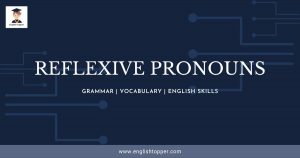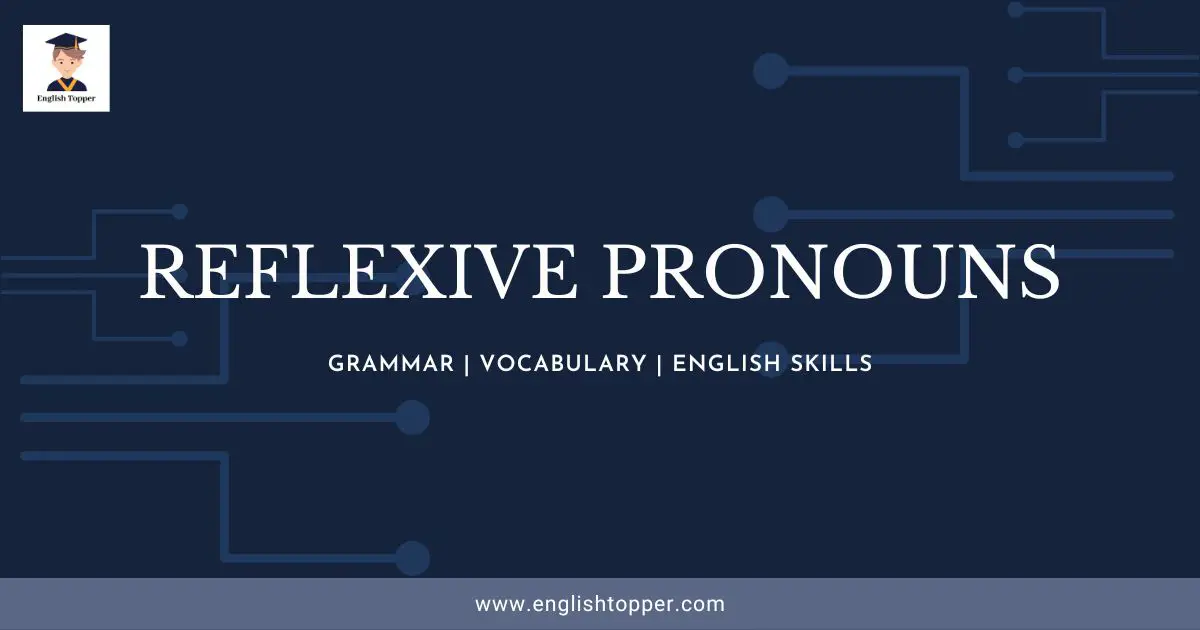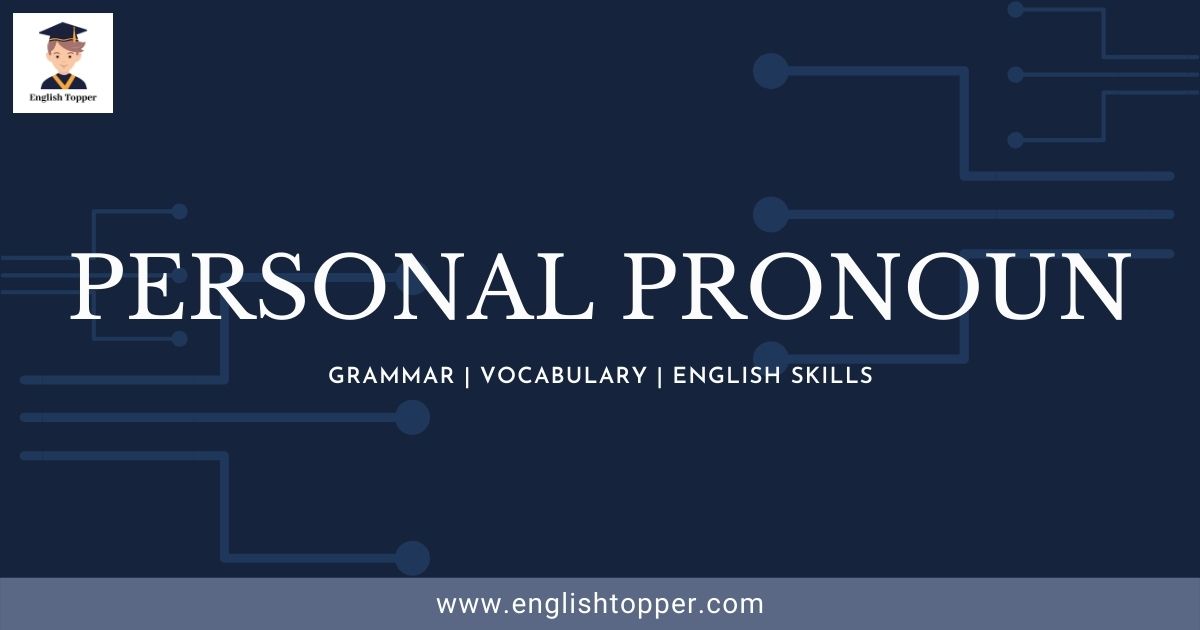Table of Contents
Reflexive Pronouns Definition in English?
A Reflexive Pronoun is a type of pronoun that is used to refer to the verb of the subject with the object’s verb within the same sentence. Here the word “Reflexive” means towards self and the sentence should have either noun or pronoun as “the subject” and “the object”.
So, in order to use, this type of pronoun the sentence must contain the same Subject and Object.
For example, consider the given sentence, “Mary taught herself how to make coffee”. Let us break down the sentence based on SVO (Subject-Verb-Object) structure.
Sentence Structure: Mary (Subject) + taught (Verb) + herself how to make coffee (Object).
In the above sentence, the Subject (Mary) and the Object (herself) are the same (which refers to the same person).
These type of pronouns always ends with either “-self” or “-selves”. Below is the list of all Reflexive Pronouns.
Related Topic: What is a Pronoun? | Pronoun Definition and Examples (2022)
Reflexive Pronouns List
S/P Form | Reflexive Pronouns |
Singular | myself |
Singular | yourself |
Singular | himself |
Singular | herself |
Singular | oneself |
Singular | itself |
Plural | ourselves |
Plural | yourselves |
Plural | themselves |
Reflexive Pronoun Examples in Sentences
To understand this topic better, let us consider a few examples of Reflexive Pronouns.
- Suraj taught himself alone for the maths exam.
- Tina questioned herself whether she can reach the bus stop on time.
- I promised myself that I am not going to cheat from today onwards.
- It is not good to think only of oneself.
- The behaviour of a person itself reveals whether a person is good or not.
- Do you think you can complete all of these assignments by yourself alone?
- We can handle this situation by ourselves.
- Don’t put yourselves at risk, ever.
- They themselves need to realize and understand the importance of having knowledge and skills before they apply for any jobs.
How and When to Use a Reflexive Pronoun?
As we discussed earlier, the Reflexive Pronoun must be used only when there is only one reference used in the sentence. It can be either a person or a group. In other words, the doer and the receiver should be the same.
For example, consider the below example.
Example Sentence 1: They looked at them.
In the above example, it is not clear whether they are looking at themselves or at others.
Example Sentence 2: They looked at themselves.
Here, it is clear that they are looking at themselves.
Reflexive pronouns as direct or indirect objects
1) Direct Object: The Reflexive Pronoun can be a direct object in a sentence when the subject and the object are the same.
Example Sentences:
- Emily decided to reward Sophia with a dinner out.
Sentence Structure 1: Emily (Subject) + decided (Verb) + to reward Sophia with a dinner out (Object).
In the above sentence, “Sophia” is the object of the reward and “Emily” is the subject. So, both are not the same (i.e, they are two different persons). Let us consider another sentence.
- Emily decided to reward herself with a dinner out.
Sentence Structure 2: Emily (Subject) + decided (Verb) + to reward herself with a dinner out (Object).
In the above sentence, “herself” is the object of the reward and “Emily” is the subject. So, both are the same (i.e, referring to the same person).
Hence, sentence 2 is the right example for the Direct Object.
2) Indirect Object: The Reflexive Pronoun can be an indirect object in a sentence when the subject and the direct object are the same.
Example Sentences:
- Incorrect: Shaun learned to fly a kite by Shaun. (X)
Sentence Structure 1: Shaun (Subject) + learned (Verb) + to fly a kite by Shaun (Object).
The above sentence uses the same subject in place of the object (without using the Reflexive Pronoun), so the sentence sounds a bit different/incorrect. Now let us look into another sentence.
- Correct: Shaun learned to fly a kite by himself. (_/)
Sentence Structure 2: Shaun (Subject) + learned (Verb) + to fly a kite by himself (Object).
Hence, the above sentence uses a Reflexive Pronoun in place of the object and sounds much better than the previous one. So, this sentence is a correct example of an Indirect object.
Related Topics: What is a Direct Object in a Sentence? (Guide 2022) and What is an Indirect Object? (Definition & Examples 2022)
Reflexive Pronouns as the Object of a Preposition
The Reflexive Pronoun can be an object of a preposition in a sentence when the subject and the object are the same.
- They had to work for themselves.
- She was feeling very sorry for himself.
In the first sentence, the preposition (for) is used between the verb (work) and object pronoun (themselves). Whereas, in the second sentence, the preposition (for) is used in between the verb (feeling) and object (himself).
If you’re unsure about the topic “Object of a Preposition”, you can read it in detail from the below link.
Related Topics: Object of a Preposition
Reflexive Pronouns as Preposition (by)
The Reflexive Pronoun can be used to show something that has been achieved by someone without the help of anyone.
Example Sentences:
- The children prepared food by themselves.
- Alex had prepared a small motorboat toy by himself.
- She is doing her household work the whole day by herself.
In the above sentences, the preposition “by” is used to mention the activity that was done by the person/group alone.
Reflexive Pronouns as Intensive
The Reflexive Pronoun can be used intensively to emphasize/highlight work or something else.
Example Sentences:
- John himself finished his last month’s project.
- Emma herself revealed many secrets to others.
We can also use these pronouns at the end of the clause for emphasizing intensively.
Example Sentences:
- I made a big decision myself.
- He mended the car himself.
When Reflexive Pronouns shouldn’t be used?
These pronouns are not used under certain conditions. They are mentioned below.
Preposition of Place
Reflexive Pronouns are not used after the preposition that refers to the place.
Example Sentences:
- Incorrect: She found a wallet herself her. (X)
- Correct: She found a wallet beside her. (_/)
- Incorrect: He had a few friends with himself. (X)
- Correct: He had a few friends with him. (_/)
Common errors with Reflexive Pronouns
There are some common errors that mostly occur while using Reflexive Pronouns in the sentences. So, you need to be a bit cautious while using it.
Mistake 1: Reflexive Pronoun should not be used after the verb that people usually do for themselves.
- Incorrect: He washed himself in hot water. (X)
- Correct: He washed in hot water. (_/)
- Incorrect: He always shaved himself before going out in the evening. (X)
- Correct: He always shaved before going out in the evening. (_/)
- Incorrect: Alice dressed herself and got ready for the party. (X)
- Correct: Alice dressed and got ready for the party. (_/)
It should be used only to emphasize/highlight any particular action (verb) in the sentence.
- John dressed himself in spite of his hand injuries.
- He’s old enough to lift these boxes himself.
Mistake 2: The incorrect use of Reflexive Pronouns in compound subjects or objects in a sentence.
Example Sentence: Steve and myself will be monitoring today’s class. (X)
Since the above sentence has two different persons (Steve and I) and the usage of “myself” is incorrect.
Correct Sentence: Steve and I will be monitoring today’s class. (_/)
By using the pronoun “I”, the sentence gets proper meaning and usage is correct.
Frequently Asked Questions (FAQ)
1) What is a reflexive pronoun and examples?
Ans: A Reflexive Pronoun is used to refer to the verb of the subject with the object’s verb within the same sentence. Examples are himself, herself, themselves, ourselves, etc. This type of pronoun is only used when the subject and the object are the same in the sentence.
2) What are the 10 reflexive pronouns?
Ans: There are nine reflexive pronouns. Those are myself, yourself, himself, herself, oneself, itself, ourselves, yourselves, and themselves.
3) Which sentence uses a reflexive pronoun?
Ans: A sentence, for example, “You need to solve this question by yourself” uses a reflexive pronoun. Here, “yourself” is the reflexive pronoun.
4) What is a reflexive pronoun’s easy definition?
Ans: A Reflexive Pronoun is used to refer to both the subject and the object within the same sentence.
5) How do you teach reflexive pronouns?
Ans: The best way to teach reflexive pronouns is to make them first understand the relation between the Subject and the Object in the sentence and give some real examples that are mostly used in our daily lives.
6) Why are reflexive pronouns important?
Ans: Reflexive Pronouns are important to learn because it helps us to refer to ourselves. In other words, in some cases, the action which is done by the subject can result to the subject itself. So, in these kinds of situations, these pronouns are used.
7) Is myself a reflexive pronoun?
Ans: Yes, “myself” is a reflexive pronoun.
8) What is the reflexive pronoun of my?
Ans: The reflexive pronoun of “my” is “myself”.
Quiz Time!
#1. "My Air Conditioner adjusts ________." Choose the correct Reflexive Pronoun.
#2. "You should take care of _______." Choose the correct Reflexive Pronoun option.
#3. "All of a sudden, I created _______ a bad situation". Choose the correct option.
#4. "Jack prepared a special dish for John last night." Does the sentence contain a Reflexive Pronoun?
#5. "To keep ________ warm, we sat around the fire." Choose the correct option.
#6. "They blamed ________ for not scoring goals in the match". Choose the correct option.
#7. "Sometimes I talk to _______".
#8. "We drove ______ home from the office". Choose the correct option.
#9. "I was in a hurry, so I washed the bike _______". Choose the correct option.
#10. "My sister and myself attended a family wedding this weekend". Rewrite the sentence into the correct form.
Answer: My sister and I attended a family wedding this weekend.
Results
|
Getting your Trinity Audio player ready...
|
Hurray….. You have passed this test! 🙂
Congratulations on completing the quiz. We are happy that you have understood this topic very well.
If you want to try again, you can start this quiz by refreshing the page.
Otherwise, you can visit the next topic 🙂
|
Getting your Trinity Audio player ready...
|
Oh, sorry about that. You didn’t pass this test! 🙁
Please read the topic carefully and try again.
Summary: (What is Reflexive Pronoun?)

Here is the summary of the topic of what we have learned till now.
- A Reflexive Pronoun is a type of pronoun that is used only when the Subject and the Object are the same in the sentence.
- For example, herself, himself, yourself, ourselves, themselves, etc.
- These pronouns can also be used as the Object of Preposition, direct and indirect objects. I can also be used to emphasize particular things intensively.
- It shouldn’t be used after the preposition of place in the sentence.
- It is also not recommended to use the verbs that are commonly done by the people themselves until and unless the action is being emphasized/highlighted.
If you are interested to learn more, then you can refer to Wikipedia here.
I hope that you understood the topic. If you still have any doubts, then comment down below, and we will respond as soon as possible. Thank you 🙂







